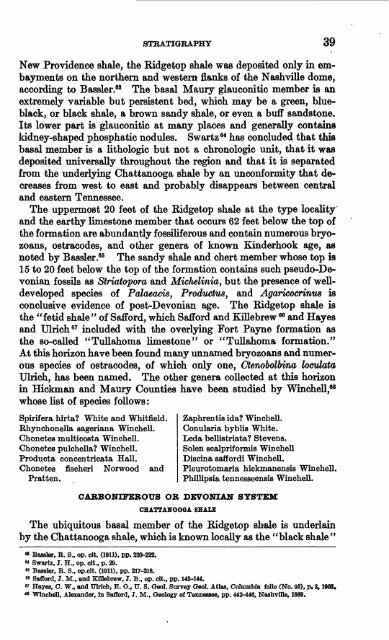GROUND WATER IN NORTH-CENTRAL TENNESSEE
GROUND WATER IN NORTH-CENTRAL TENNESSEE
GROUND WATER IN NORTH-CENTRAL TENNESSEE
You also want an ePaper? Increase the reach of your titles
YUMPU automatically turns print PDFs into web optimized ePapers that Google loves.
STRATIGRAPHY 39<br />
New Providence shale, the Ridgetop shale was deposited only in em-<br />
bayments on the northern and western flanks of the Nashville dome,<br />
according to Bassler.63 The basal Maury glauconitic member is an<br />
extremely variable but persistent bed, which may be a green, blue-<br />
black, or black shale, a brown sandy shale, or even a buff sandstone.<br />
Its lower part is glauconitic at many places and generally contains<br />
kidney-shaped phosphatic nodules. Swartz 64 has concluded that this<br />
basal member is a lithologic but not a chronologic unit, that it was<br />
deposited universally throughout the region and that it is separated<br />
from the underlying Chattanooga shale by an unconformity that de<br />
creases from west to east and probably disappears between central<br />
and eastern Tennessee.<br />
The uppermost 20 feet of the Ridgetop shale at the type locality<br />
and the earthy limestone member that occurs 62 feet below the top of<br />
the formation are abundantly fossiliferous and contain numerous bryo-<br />
zoans, ostracodes, and other genera of known Kinderhook age, as<br />
noted by Bassler.68 The sandy shale and chert member whose top is<br />
15 to 20 feet below the top of the formation contains such pseudo-De<br />
vonian fossils as Striatopora and Michelinia, but the presence of well-<br />
developed species of Palaeads, Productus, and Agaricocrinus is<br />
conclusive evidence of post-Devonian age. The Ridgetop shale is<br />
the "fetid shale" of Safford, which Safford and Killebrew 66 and Hayes<br />
and Ulrich 67 included with the overlying Fort Payne formation as<br />
the so-called "Tullahoma limestone" or "Tullahoma formation."<br />
At this horizon have been found many unnamed bryozoans and numer<br />
ous species of ostracodes, of which only one, Ctenobolbina loevlata<br />
Ulrich, has been named. The other genera collected at this horizon<br />
in Hickman and Maury Counties have been studied by Winchell,68<br />
whose list of species follows:<br />
Spirifera hirta? White and Whitfield.<br />
Rhynchonella sageriana Winchell.<br />
Chonetes multicosta Winchell.<br />
Chonetes pulchella? Winchell.<br />
Producta concentricata Hall.<br />
Chonetes fischeri Norwood and<br />
Pratten.<br />
Zaphrentis ida? Winchell.<br />
Conularia byblis White.<br />
Leda bellistriata? Stevens.<br />
Solen scalpriformis Winchell<br />
Discina saffordi Winchell.<br />
Pleurotomaria hickmanensis Winchell.<br />
Phillipsia tennesseensis Winchell.<br />
CARBONIFEROUS OB DEVONIAN SYSTEM<br />
CHATTANOOGA SHAIE<br />
The ubiquitous basal member of the Ridgetop shale is underlain<br />
by the Chattanooga shale, which is known locally as the "black shale "<br />
» Bassler, R. S., op. cit. (1911), pp. 220-222.<br />
64 Swartz, J. H., op. cit., p. 29.<br />
w Bassler, R. S., op.cit. (1911), pp. 217-218.<br />
66 Safford, J. M., and Killebrew, J. B., op. cit., pp. 143-144.<br />
" Hayes, O. W., and Ulrich, E. O., U. S. Qeol. Survey Oeol. Atlas, Columbia folio (No. 95), p. 3,1908.<br />
« Winchell, Alexander, in Safford, J. M., Geology of Tennessee, pp. 442-446, Nashville, 1869.

















